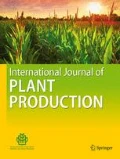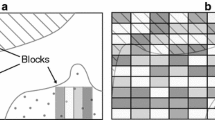Abstract
Rational fertilizer management is crucial in the efficient use of resources that are basically non-renewable and that can have a great environmental impact when used without scientific basis. The availability of scientifically sound decision-making tools for rational fertilization is scarce. We have developed a Windows program to calculate the required seasonal N, P and K rates, and the most cost-effective combination of commercial fertilizers. The tool also provides estimates of the Ca, Mg and S balances in the field resulting from the fertilizer program chosen. Novel aspects of the calculations include the development of stochastic flexible fertilizer programs for N and the calculation of acidification and N losses. Regarding P and K, estimations are provided on the grounds of threshold values of usual availability indexes, something frequently unknown by final users. Also, it allows the users to determine the best complex fertilizer for pre-plant applications to avoid blending of simple fertilizers at the farm, a task usually complex for farmers. The application may be useful both to the fertilizer supply and demand sides. In addition, it may be used for teaching as it helps understanding the rationale behind this management practice.

Similar content being viewed by others
References
Anonymous. (2005). Agenda 21 de la provincia de Jaen, Desarrollo Socioeconómico Agricultura. http://www.agenda21jaen.com/export/sites/default/galerias/galeriaDescargas/agenda21/Aplicaciones/documentacion/Diagnosis-provincial/23._Turismo.pdf. Accessed 24 Feb 2019.
Anuario Estadístico de Andalucía. (2015). Statistics on crop production, land use and fertilizer sales provided by Junta de Andalucía (Andalusian Regional Government). https://www.juntadeandalucia.es/institutodeestadisticaycartografia/badea/informe/anual?CodOper=b3_6&idNode=6049. Accessed 24 Sept 2019.
Arregui, L. M., & Quemada, M. (2006). Drainage and nitrate leaching in a crop rotation under different N strategies: application of capacitance probes. Plant and Soil,288, 57–69.
Arregui, L. M., & Quemada, M. (2008). Strategies to improve nitrogen-use efficiency in winter cereal crops under rainfed Mediterranean conditions. Agronomy Journal,100, 277–284.
Bolan, N. S., & Hedley, M. J. (2003). The role of carbon, nitrogen and sulphur in soil acidification. In Z. Rengel (Ed.), Hand book of soil acidification. New York: Marcel and Dekker.
Connor, D. J., Loomis, R. S., & Cassman, K. G. (2011). Crop ecology: productivity and management in agricultural systems. Cambridge: Cambridge University Press.
Delgado, A., Quemada, M., & Villalobos, F. J. (2016a). Fertilizers. In F. J. Villalobos & E. Fereres (Eds.), Principles of agronomy for sustainable agriculture (pp. 321–340). Cham: Springer.
Delgado, A., Quemada, M., Villalobos, F. J., & Mateos, L. (2016b). Fertilization with phosphorus, potassium and other nutrients. In F. J. Villalobos & E. Fereres (Eds.), Principles of agronomy for sustainable agriculture (pp. 381–406). Cham: Springer.
Delgado, A., & Scalenghe, R. (2008). Aspects of phosphorus transfer in Europe. Journal of Plant Nutrition and Soil Science,171, 552–575.
EMEP. (2019). http://www.emep.int/. Accessed 24 Sept 2019.
Gabriel, J. L., Lizaso, J., & Quemada, M. (2010). Laboratory versus field calibration of capacitance probes. Soil Science Society of America Journal,74, 593–601.
Grassini, P., & Cassman, K. G. (2012). High-yield maize with large net energy yield and small global warming intensity. Proceedings of National Academy of Sciences,109(4), 1074–1079.
López-Bernal, A., Alcantara, E., & Villalobos, F. J. (2014). Thermal properties of sapwood of fruit trees as affected by anatomy and water potential: errors in sap flux density measurements based on heat pulse methods. Trees,28(6), 1623–1634.
Neyroud, J. A., & Lischer, P. (2003). Do different methods used to estimate soil phosphorous availability across Europe give comparable results? Journal of Plant Nutrition,166, 422–431.
Olsen, S. R., Cole, C. V., Watanabe, F. S., & Dean, L. A. (1954). Estimation of available phosphorous in soils by extraction with sodium bicarbonate. Washington: United States Department of Agriculture.
Peragón, J. M., Pérez-Latorre, F. J., & Delgado, A. (2017). A GIS-based tool for integrated management of clogging risk and nitrogen fertilization in drip irrigation. Agricultural Water Management,184, 86–95.
Prummel, J. (1960). Placement of a compound (NPK) fertilizer compared with straight fertilizers. Netherlands Journal of Agricultural Science,8(2), 149–154.
Quemada, M. (2006). Balance de nitrógeno en sistemas de cultivo de cereal de invierno y de maíz en varias regiones españolas. Monografías INIA Serie Agrícola nº 22. Madrid: Instituto Nacional de Investigación y Tecnología Agraria y Alimentaria.
Quemada, M., Delgado, A., Mateos, L., & Villalobos, F. J. (2016a). Nitrogen fertilization I: The nitrogen balance. In F. J. Villalobos & E. Fereres (Eds.), Principles of agronomy for sustainable agriculture (pp. 341–368). Cham: Springer.
Quemada, M., Delgado, A., Mateos, L., & Villalobos, F. J. (2016b). Nitrogen fertilization II: Fertilizer requirements. In F. J. Villalobos & E. Fereres (Eds.), Principles of agronomy for sustainable agriculture (pp. 369–380). Cham: Springer.
Quemada, M., & Menacho, E. (2001). Soil respiration 1 year after sewage sludge application. Biology and Fertility of Soils,33, 344–346.
R Core Team. (2018). R: A Language and Environment for Statistical Computing. Vienna: R Foundation for Statistical Computing.
Recena, R., Díaz, I., del Campillo, M. C., Torrent, J., & Delgado, A. (2016). Calculation of threshold Olsen P values for fertilizer response from soil properties. Agronomy for Sustainable Development,36, 54.
Sadras, V. O., Villalobos, F. J., & Fereres, E. (2016). Radiation interception, radiation use efficiency and crop productivity. In F. J. Villalobos & E. Fereres (Eds.), Principles of agronomy for sustainable agriculture (pp. 169–188). Cham: Springer.
Scherer, H. W. (2001). Sulphur in crop production. European Journal of Agronomy,14(2), 81–111.
Schröder, J. J., Schulte, R. P. O., Creamer, R. E., Delgado, A., van Leeuwen, J., Lehtinen, T., et al. (2016). The elusive role of soil quality in nutrient cycling: a review. Soil Use and Management,32, 476–486.
Virk, S. S., Mullenix, D. K., Sharda, A., Hall, J. B., Wood, C. W., Fasina, O. O., et al. (2013). Case study: distribution uniformity of a blended fertilizer applied using a variable-rate spinner-disc spreader. Applied Engineering in Agriculture,29(5), 1–10.
Xu, X., He, P., Pampolino, M. F., Li, Y., Liu, S., Xie, J., et al. (2016). Narrowing yield gaps and increasing nutrient use efficiencies using the nutrient expert system for maize in Northeast China. Field Crops Research,194, 75–82.
Acknowledgements
F. Orgaz, Majid Jami Al-Ahmadi and Behnam Kamkar contributed to improving the earliest version of the program. This work was supported by ERA-NET FACCE SURPLUS (Grant number APCIN 652615, project OLIVE-MIRACLE), being co-funded by INIA of Spain.
Author information
Authors and Affiliations
Corresponding author
Ethics declarations
Conflict of interest
The authors declare no potential conflict of interest for this research.
Appendices
Appendix A1. Calculation of N Requirements
N fertilizer requirements (N rate) are calculated from:
In this equation, Nend represents the final soil inorganic N (residual N). FertiliCalc uses a fixed value of 10 kg N ha−1 assuming that crops are unable to recover N below that threshold. fNR is the ratio of N in roots to N in shoots. Nyield and Nres refer to N accumulated in the harvest organ and residues of the present crop, respectively, while their homologous N′yield and N′res correspond to the previous crop in the rotation. These values are easily calculated from the product of concentrations of N in harvested organs and residues and their biomass (Quemada et al. 2016a). The coefficient kim would have a maximum value of 1 if all the aboveground residues were mineralized with no loss. Lower values are expected if the residues are not incorporated by tillage or when the N concentration in residues is low. FertiliCalc adopts different values depending on whether the crop is a legume and whether it is tilt. Fres is the fraction of residues that are left in the field (user-defined input; otherwise the application provides default values depending on the crop). Nother is the total N received by atmospheric deposition, symbiotic fixation and irrigation water. In the case of non-legume crops, FertiliCalc adopts a default value. For legume crops, the application calculates Nother as a fraction of the crop N (ffix):
where ffix takes different values depending on the type of legume crop (annual or perennial) and the percentage of soil organic matter (Quemada et al. 2016a). Finally, the coefficient n in Eq. (6) represents the fraction of applied N that is lost (leaching, volatilization, denitrification). Depending on soil texture, FertiliCalc assumes that leaching ranges from 20% (sandy) to 2% (clayish). The rates of volatilization of ammonia and denitrification are determined according to Quemada et al. (2016b).
The model assumes that most of N supplied by mineralization, atmospheric deposition, symbiotic fixation and contained in the irrigation water, are taken up by crops with no losses. Table 4 provides a list with the values of the aforementioned parameter used by FertiliCalc in the calculation of N rate.
Appendix A2. Conversion Factors for Soil P Tests
When soil P data available have not been determined by the Olsen method, FertiliCalc estimates the equivalent Olsen STL (STLOlsen) as:
where STLi is the soil test level determined by the method “i” and k a conversion factor that is method-specific. Values for k have been calculated from data reported in Neyroud and Lischer (2003) and are presented in Table 5.
Rights and permissions
About this article
Cite this article
Villalobos, F.J., Delgado, A., López-Bernal, Á. et al. FertiliCalc: A Decision Support System for Fertilizer Management. Int. J. Plant Prod. 14, 299–308 (2020). https://doi.org/10.1007/s42106-019-00085-1
Received:
Accepted:
Published:
Issue Date:
DOI: https://doi.org/10.1007/s42106-019-00085-1




